Brand Management Report: Coca-Cola Brand Equity and Portfolio Analysis
VerifiedAdded on 2021/01/02
|22
|6068
|161
Report
AI Summary
This report provides a comprehensive analysis of brand management principles, with a specific focus on the brand strategies employed by Coca-Cola. The report begins with an introduction to brand management, brand equity, and the role of marketing in building a successful brand, using Optimum Impression Ltd. as an example. It then delves into the application of Aaker's Brand Equity Model, exploring concepts such as brand loyalty, awareness, perceived quality, brand associations, proprietary assets, brand extension, and brand reinforcement and revitalization. The second part of the report focuses on Coca-Cola's brand portfolio strategy, hierarchy management, and the strategies used to manage brand equity within its diverse portfolio. It examines the strengths of the Coca-Cola brand, areas needing improvement, and collaborative partnerships. Finally, the report evaluates the techniques Coca-Cola utilizes for measuring and managing brand value, market share, consumer attitudes, and purchasing intent, concluding with an overall assessment of the company's brand management practices.
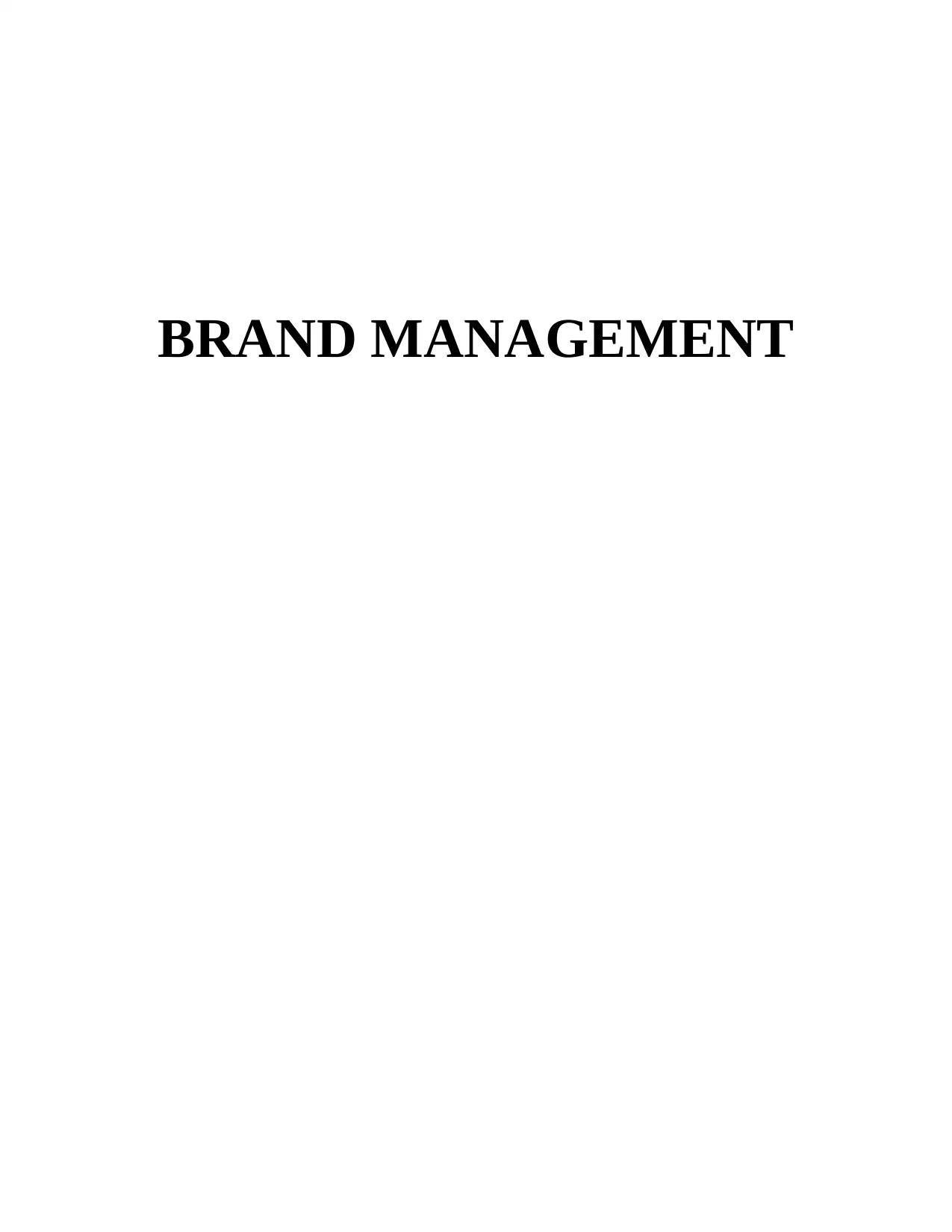
BRAND MANAGEMENT
Paraphrase This Document
Need a fresh take? Get an instant paraphrase of this document with our AI Paraphraser

Table of Contents
INTRODUCTION...........................................................................................................................1
TASK 1............................................................................................................................................1
Introduction............................................................................................................................1
Main body...............................................................................................................................3
Conclusion..............................................................................................................................6
TASK 2............................................................................................................................................7
Brand portfolio strategy of Coca-Cola...................................................................................7
Hierarchy management of brands...........................................................................................8
Strategies used for managing brand equity within the organisation's portfolio...................11
TASK 3..........................................................................................................................................12
Strengths of the brand that can be leveraged........................................................................12
Weaknesses that need attention............................................................................................14
Collaborative and partnership agreement linked to the brand..............................................14
TASK 4..........................................................................................................................................15
Evaluating the techniques utilised by Coca- Cola for measuring as well as managing ......15
CONCLUSION..............................................................................................................................17
REFERENCES..............................................................................................................................18
INTRODUCTION...........................................................................................................................1
TASK 1............................................................................................................................................1
Introduction............................................................................................................................1
Main body...............................................................................................................................3
Conclusion..............................................................................................................................6
TASK 2............................................................................................................................................7
Brand portfolio strategy of Coca-Cola...................................................................................7
Hierarchy management of brands...........................................................................................8
Strategies used for managing brand equity within the organisation's portfolio...................11
TASK 3..........................................................................................................................................12
Strengths of the brand that can be leveraged........................................................................12
Weaknesses that need attention............................................................................................14
Collaborative and partnership agreement linked to the brand..............................................14
TASK 4..........................................................................................................................................15
Evaluating the techniques utilised by Coca- Cola for measuring as well as managing ......15
CONCLUSION..............................................................................................................................17
REFERENCES..............................................................................................................................18

⊘ This is a preview!⊘
Do you want full access?
Subscribe today to unlock all pages.

Trusted by 1+ million students worldwide
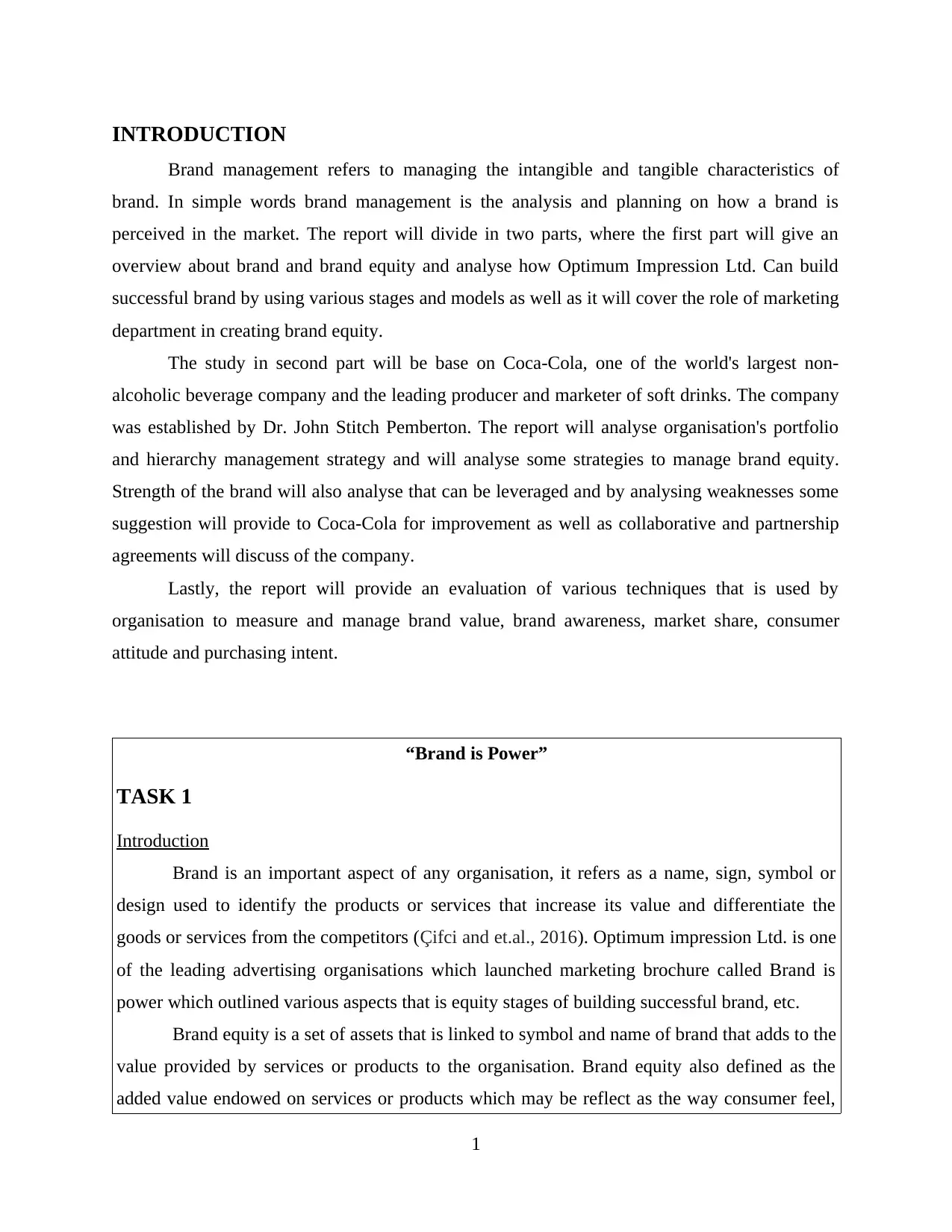
INTRODUCTION
Brand management refers to managing the intangible and tangible characteristics of
brand. In simple words brand management is the analysis and planning on how a brand is
perceived in the market. The report will divide in two parts, where the first part will give an
overview about brand and brand equity and analyse how Optimum Impression Ltd. Can build
successful brand by using various stages and models as well as it will cover the role of marketing
department in creating brand equity.
The study in second part will be base on Coca-Cola, one of the world's largest non-
alcoholic beverage company and the leading producer and marketer of soft drinks. The company
was established by Dr. John Stitch Pemberton. The report will analyse organisation's portfolio
and hierarchy management strategy and will analyse some strategies to manage brand equity.
Strength of the brand will also analyse that can be leveraged and by analysing weaknesses some
suggestion will provide to Coca-Cola for improvement as well as collaborative and partnership
agreements will discuss of the company.
Lastly, the report will provide an evaluation of various techniques that is used by
organisation to measure and manage brand value, brand awareness, market share, consumer
attitude and purchasing intent.
“Brand is Power”
TASK 1
Introduction
Brand is an important aspect of any organisation, it refers as a name, sign, symbol or
design used to identify the products or services that increase its value and differentiate the
goods or services from the competitors (Çifci and et.al., 2016). Optimum impression Ltd. is one
of the leading advertising organisations which launched marketing brochure called Brand is
power which outlined various aspects that is equity stages of building successful brand, etc.
Brand equity is a set of assets that is linked to symbol and name of brand that adds to the
value provided by services or products to the organisation. Brand equity also defined as the
added value endowed on services or products which may be reflect as the way consumer feel,
1
Brand management refers to managing the intangible and tangible characteristics of
brand. In simple words brand management is the analysis and planning on how a brand is
perceived in the market. The report will divide in two parts, where the first part will give an
overview about brand and brand equity and analyse how Optimum Impression Ltd. Can build
successful brand by using various stages and models as well as it will cover the role of marketing
department in creating brand equity.
The study in second part will be base on Coca-Cola, one of the world's largest non-
alcoholic beverage company and the leading producer and marketer of soft drinks. The company
was established by Dr. John Stitch Pemberton. The report will analyse organisation's portfolio
and hierarchy management strategy and will analyse some strategies to manage brand equity.
Strength of the brand will also analyse that can be leveraged and by analysing weaknesses some
suggestion will provide to Coca-Cola for improvement as well as collaborative and partnership
agreements will discuss of the company.
Lastly, the report will provide an evaluation of various techniques that is used by
organisation to measure and manage brand value, brand awareness, market share, consumer
attitude and purchasing intent.
“Brand is Power”
TASK 1
Introduction
Brand is an important aspect of any organisation, it refers as a name, sign, symbol or
design used to identify the products or services that increase its value and differentiate the
goods or services from the competitors (Çifci and et.al., 2016). Optimum impression Ltd. is one
of the leading advertising organisations which launched marketing brochure called Brand is
power which outlined various aspects that is equity stages of building successful brand, etc.
Brand equity is a set of assets that is linked to symbol and name of brand that adds to the
value provided by services or products to the organisation. Brand equity also defined as the
added value endowed on services or products which may be reflect as the way consumer feel,
1
Paraphrase This Document
Need a fresh take? Get an instant paraphrase of this document with our AI Paraphraser
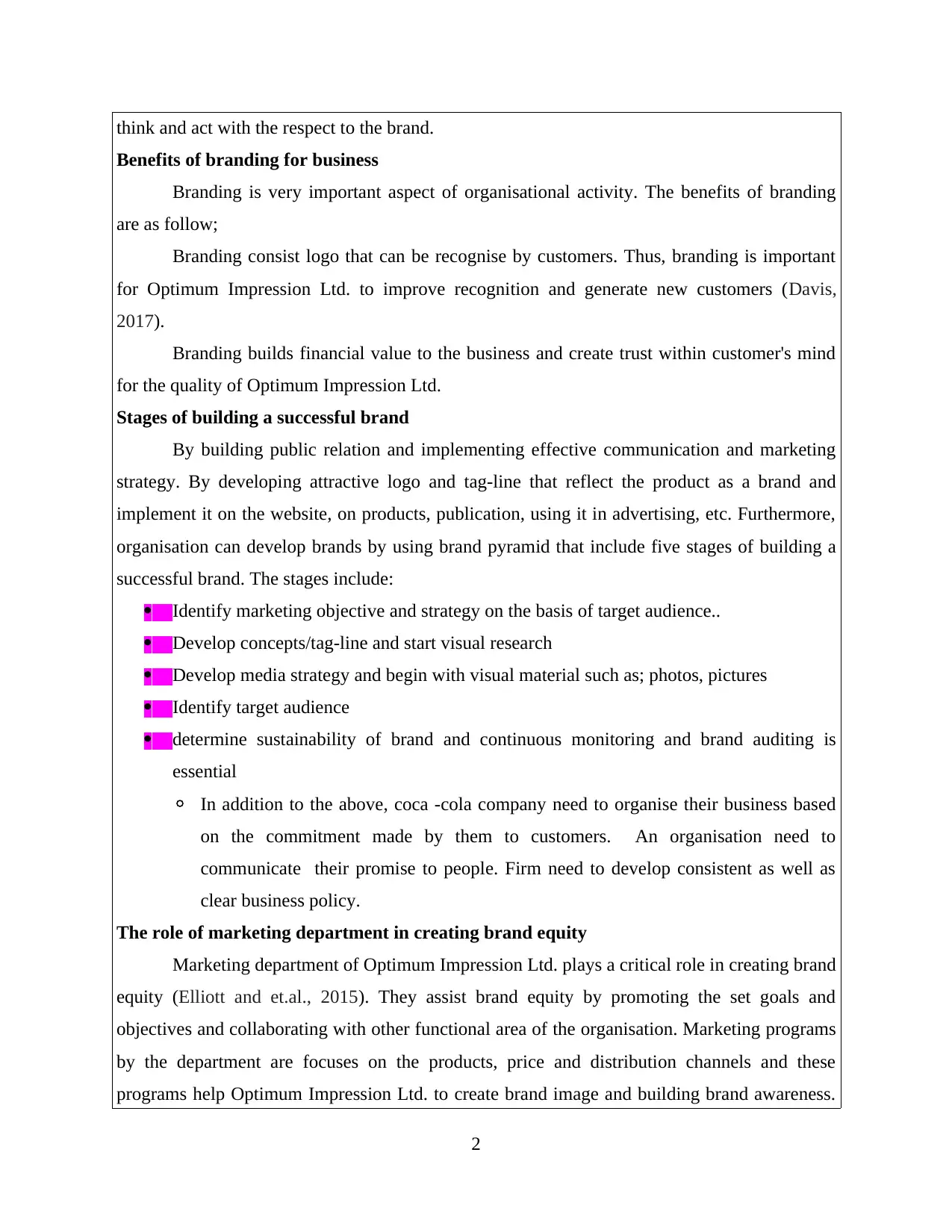
think and act with the respect to the brand.
Benefits of branding for business
Branding is very important aspect of organisational activity. The benefits of branding
are as follow;
Branding consist logo that can be recognise by customers. Thus, branding is important
for Optimum Impression Ltd. to improve recognition and generate new customers (Davis,
2017).
Branding builds financial value to the business and create trust within customer's mind
for the quality of Optimum Impression Ltd.
Stages of building a successful brand
By building public relation and implementing effective communication and marketing
strategy. By developing attractive logo and tag-line that reflect the product as a brand and
implement it on the website, on products, publication, using it in advertising, etc. Furthermore,
organisation can develop brands by using brand pyramid that include five stages of building a
successful brand. The stages include:
Identify marketing objective and strategy on the basis of target audience..
Develop concepts/tag-line and start visual research
Develop media strategy and begin with visual material such as; photos, pictures
Identify target audience
determine sustainability of brand and continuous monitoring and brand auditing is
essential
◦ In addition to the above, coca -cola company need to organise their business based
on the commitment made by them to customers. An organisation need to
communicate their promise to people. Firm need to develop consistent as well as
clear business policy.
The role of marketing department in creating brand equity
Marketing department of Optimum Impression Ltd. plays a critical role in creating brand
equity (Elliott and et.al., 2015). They assist brand equity by promoting the set goals and
objectives and collaborating with other functional area of the organisation. Marketing programs
by the department are focuses on the products, price and distribution channels and these
programs help Optimum Impression Ltd. to create brand image and building brand awareness.
2
Benefits of branding for business
Branding is very important aspect of organisational activity. The benefits of branding
are as follow;
Branding consist logo that can be recognise by customers. Thus, branding is important
for Optimum Impression Ltd. to improve recognition and generate new customers (Davis,
2017).
Branding builds financial value to the business and create trust within customer's mind
for the quality of Optimum Impression Ltd.
Stages of building a successful brand
By building public relation and implementing effective communication and marketing
strategy. By developing attractive logo and tag-line that reflect the product as a brand and
implement it on the website, on products, publication, using it in advertising, etc. Furthermore,
organisation can develop brands by using brand pyramid that include five stages of building a
successful brand. The stages include:
Identify marketing objective and strategy on the basis of target audience..
Develop concepts/tag-line and start visual research
Develop media strategy and begin with visual material such as; photos, pictures
Identify target audience
determine sustainability of brand and continuous monitoring and brand auditing is
essential
◦ In addition to the above, coca -cola company need to organise their business based
on the commitment made by them to customers. An organisation need to
communicate their promise to people. Firm need to develop consistent as well as
clear business policy.
The role of marketing department in creating brand equity
Marketing department of Optimum Impression Ltd. plays a critical role in creating brand
equity (Elliott and et.al., 2015). They assist brand equity by promoting the set goals and
objectives and collaborating with other functional area of the organisation. Marketing programs
by the department are focuses on the products, price and distribution channels and these
programs help Optimum Impression Ltd. to create brand image and building brand awareness.
2
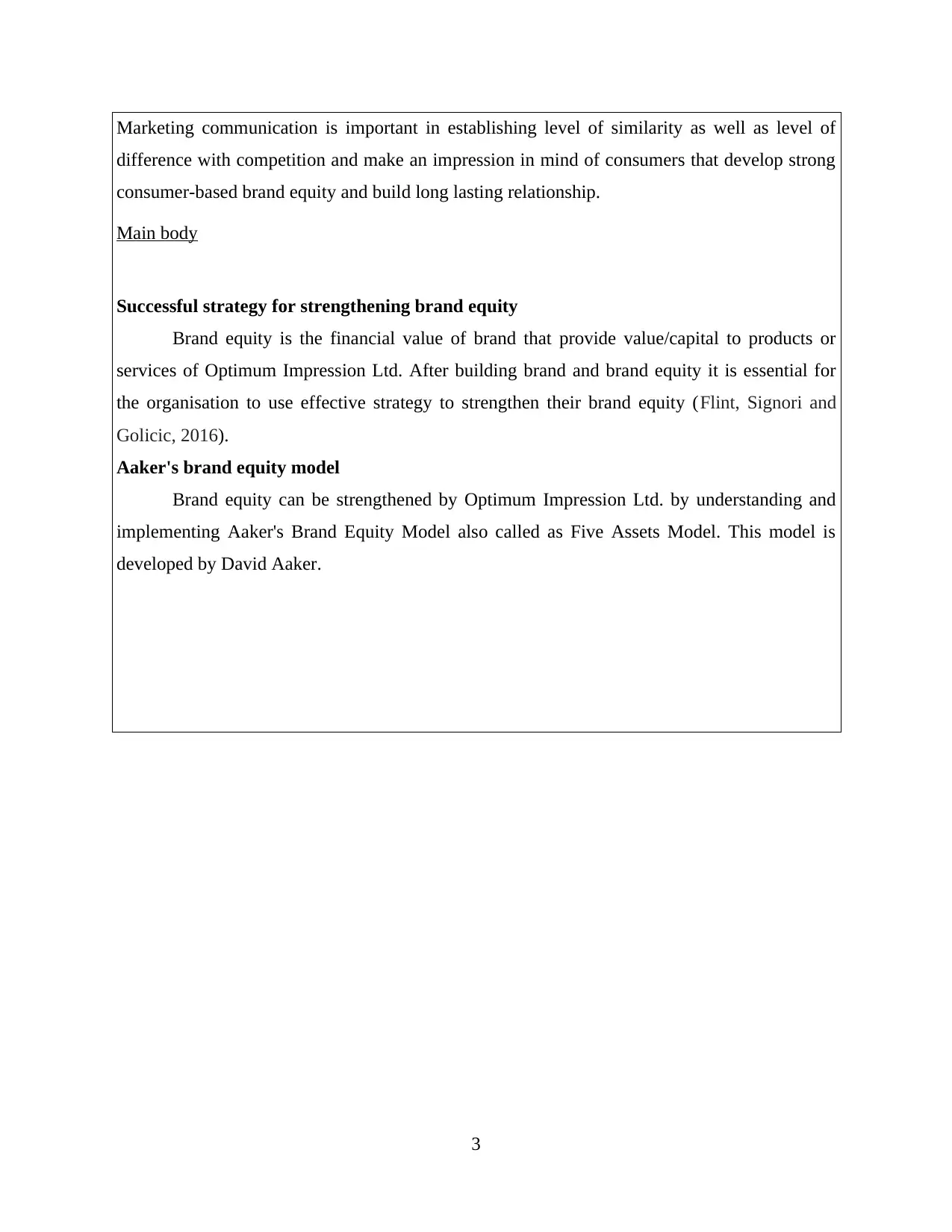
Marketing communication is important in establishing level of similarity as well as level of
difference with competition and make an impression in mind of consumers that develop strong
consumer-based brand equity and build long lasting relationship.
Main body
Successful strategy for strengthening brand equity
Brand equity is the financial value of brand that provide value/capital to products or
services of Optimum Impression Ltd. After building brand and brand equity it is essential for
the organisation to use effective strategy to strengthen their brand equity (Flint, Signori and
Golicic, 2016).
Aaker's brand equity model
Brand equity can be strengthened by Optimum Impression Ltd. by understanding and
implementing Aaker's Brand Equity Model also called as Five Assets Model. This model is
developed by David Aaker.
3
difference with competition and make an impression in mind of consumers that develop strong
consumer-based brand equity and build long lasting relationship.
Main body
Successful strategy for strengthening brand equity
Brand equity is the financial value of brand that provide value/capital to products or
services of Optimum Impression Ltd. After building brand and brand equity it is essential for
the organisation to use effective strategy to strengthen their brand equity (Flint, Signori and
Golicic, 2016).
Aaker's brand equity model
Brand equity can be strengthened by Optimum Impression Ltd. by understanding and
implementing Aaker's Brand Equity Model also called as Five Assets Model. This model is
developed by David Aaker.
3
⊘ This is a preview!⊘
Do you want full access?
Subscribe today to unlock all pages.

Trusted by 1+ million students worldwide

Brand Loyalty
According to this stage, one of the most important steps in strengthening brand equity is
to win brand loyal customers (Brand Equity, 2018). Brand loyalty refers to a commitment of
potential customers to repurchase. People can be loyal to a brand by following factors: Reduced
marketing costs, trade leverage, attracting new customer, time to respond to competitors brand.
Brand loyalty of Optimum Impression is strong. They maintain their services consistent
and fulfil the demand of consumers as well that result in consumer's commitment and their
loyalty.
Brand Awareness
Brand awareness is the degree to which brand is recognised by potential target
customers. Brand awareness is something that is very important for business to enhance brand
4
Illustration 1: Aaker's Model of Brand Equity
(Source: Brand Equity, 2018)
According to this stage, one of the most important steps in strengthening brand equity is
to win brand loyal customers (Brand Equity, 2018). Brand loyalty refers to a commitment of
potential customers to repurchase. People can be loyal to a brand by following factors: Reduced
marketing costs, trade leverage, attracting new customer, time to respond to competitors brand.
Brand loyalty of Optimum Impression is strong. They maintain their services consistent
and fulfil the demand of consumers as well that result in consumer's commitment and their
loyalty.
Brand Awareness
Brand awareness is the degree to which brand is recognised by potential target
customers. Brand awareness is something that is very important for business to enhance brand
4
Illustration 1: Aaker's Model of Brand Equity
(Source: Brand Equity, 2018)
Paraphrase This Document
Need a fresh take? Get an instant paraphrase of this document with our AI Paraphraser

equity and attain loyal consumer.
The awareness of brand according to Optimum Impression if the firm is on moderate
level and they need to implement the steps to influence brand awareness. It can be achieved by
Attach association to the brand that help in influence brand awareness and Brand awareness can
be increase by increasing familiarity with customers as familiar consumer will speak more
about brand that influence brand awareness.
Perceived Quality
Perceived quality can be defined as the perception of consumers to the overall quality of
services or products. Strengthening brand equity to provide good quality services to customers
(Heding, Knudtzen and Bjerre, 2015). This step includes; quality of products that being a reason
for consumers to have the services of the organisation, the level of differentiation/ position in
compare to the competition brand, etc.
For example, if quality of services of business is high and their price point, additional
features offered to the associated company make them able to maintain brand equity.
Brand Association
Brand associations are the attribute of a brand that come into customer's mind when the
brand is talked about. In this stage, brand association is not beneficial for organisation, the
images and symbol that are associated with a brand is beneficial for brand equity. It can be
based on; Advertisement, word of mouth, association with celebrity, etc.
Optimum Impression Ltd. advertise for many famous companies and for many
celebrities that make them recognised in consumer's mind. Their services are on reasonable
price. Apart from that, their marketing activity and strategy need some improvement.
Proprietary Assets
Proprietary assets include; patents, trademarks, copyrights and other intellectual
property rights. According to this stage the more proprietary asset a brand has, brand
competency is greater in the market (Hsu, Fournier and Srinivasan, 2016). Proprietary asset
help them to compete in the market effectively and strengthening brand equity to attain
competitive advantage.
Brand Extension
Brand extension involve using the name of existing brand name to introducer or launch
new product category. According to this strategy business can leverage brand value/equity by
5
The awareness of brand according to Optimum Impression if the firm is on moderate
level and they need to implement the steps to influence brand awareness. It can be achieved by
Attach association to the brand that help in influence brand awareness and Brand awareness can
be increase by increasing familiarity with customers as familiar consumer will speak more
about brand that influence brand awareness.
Perceived Quality
Perceived quality can be defined as the perception of consumers to the overall quality of
services or products. Strengthening brand equity to provide good quality services to customers
(Heding, Knudtzen and Bjerre, 2015). This step includes; quality of products that being a reason
for consumers to have the services of the organisation, the level of differentiation/ position in
compare to the competition brand, etc.
For example, if quality of services of business is high and their price point, additional
features offered to the associated company make them able to maintain brand equity.
Brand Association
Brand associations are the attribute of a brand that come into customer's mind when the
brand is talked about. In this stage, brand association is not beneficial for organisation, the
images and symbol that are associated with a brand is beneficial for brand equity. It can be
based on; Advertisement, word of mouth, association with celebrity, etc.
Optimum Impression Ltd. advertise for many famous companies and for many
celebrities that make them recognised in consumer's mind. Their services are on reasonable
price. Apart from that, their marketing activity and strategy need some improvement.
Proprietary Assets
Proprietary assets include; patents, trademarks, copyrights and other intellectual
property rights. According to this stage the more proprietary asset a brand has, brand
competency is greater in the market (Hsu, Fournier and Srinivasan, 2016). Proprietary asset
help them to compete in the market effectively and strengthening brand equity to attain
competitive advantage.
Brand Extension
Brand extension involve using the name of existing brand name to introducer or launch
new product category. According to this strategy business can leverage brand value/equity by
5

introducing logical and complementary new product category. There are two type of brand
extension; Line and category.
For example, Optimum Impression Ltd. increase profitability by offering more than one
service category. They also can extend their services globally that help them to reach a wide
range of customers and build brand image across the border (Jugenheimer, Sheehan and Kelley,
2015).
Brand Reinforcement and Revitalisation
Brand reinforcement refers to maintaining brand equity and making sure that the
customers do have desired knowledge so that the brand able to satisfy consumers need and build
the image. This can be done by marketing activities such as; advertising, events and
sponsorship, etc. by creating brand awareness. It is suggested to the organisation to build
effective reinforcement strategy and continue monitor emergence of new technology and what
change comes in consumers taste and preferences.
Brand Revitalisation
Brand revitalisation is the marketing strategy employed when a brand has reached to the
maturity and their profits are begun to the decline stage. It is essential for Optimum impression
to know what marketing or managerial actions possibly revitalise the brand in consumer's mind.
It is suggested to the organisation for successfully revive the brand by increase differentiation
by continuous innovation (Keller and Brexendorf, 2017). The reason of brand revitalisation for
the organisation is; Struggling industry environment, Easy entry of competitors, Stiff
competition, etc. Revitalisation can be done through market expansion, brand repositioning and
modification in products or services.
Conclusion
Branding is not just about getting the target market to select the organisation over the
competition. It is also about to deliver the brand to the consumers as a sole provider of a
solution to their issues. Branding as a marketing tool clearly deliver the message, vision of
Optimum Impression Ltd. To the potential customers.
It conforms the credibility of brand in marketplace and emotionally connect to target
customers with services or products of the company (Spry and Lukas, 2016). In similar to
marketing activity branding also help the organisation to promote its services and products and
motivate buyer to make purchase. It helps the organisation to research about consumers need,
6
extension; Line and category.
For example, Optimum Impression Ltd. increase profitability by offering more than one
service category. They also can extend their services globally that help them to reach a wide
range of customers and build brand image across the border (Jugenheimer, Sheehan and Kelley,
2015).
Brand Reinforcement and Revitalisation
Brand reinforcement refers to maintaining brand equity and making sure that the
customers do have desired knowledge so that the brand able to satisfy consumers need and build
the image. This can be done by marketing activities such as; advertising, events and
sponsorship, etc. by creating brand awareness. It is suggested to the organisation to build
effective reinforcement strategy and continue monitor emergence of new technology and what
change comes in consumers taste and preferences.
Brand Revitalisation
Brand revitalisation is the marketing strategy employed when a brand has reached to the
maturity and their profits are begun to the decline stage. It is essential for Optimum impression
to know what marketing or managerial actions possibly revitalise the brand in consumer's mind.
It is suggested to the organisation for successfully revive the brand by increase differentiation
by continuous innovation (Keller and Brexendorf, 2017). The reason of brand revitalisation for
the organisation is; Struggling industry environment, Easy entry of competitors, Stiff
competition, etc. Revitalisation can be done through market expansion, brand repositioning and
modification in products or services.
Conclusion
Branding is not just about getting the target market to select the organisation over the
competition. It is also about to deliver the brand to the consumers as a sole provider of a
solution to their issues. Branding as a marketing tool clearly deliver the message, vision of
Optimum Impression Ltd. To the potential customers.
It conforms the credibility of brand in marketplace and emotionally connect to target
customers with services or products of the company (Spry and Lukas, 2016). In similar to
marketing activity branding also help the organisation to promote its services and products and
motivate buyer to make purchase. It helps the organisation to research about consumers need,
6
⊘ This is a preview!⊘
Do you want full access?
Subscribe today to unlock all pages.

Trusted by 1+ million students worldwide
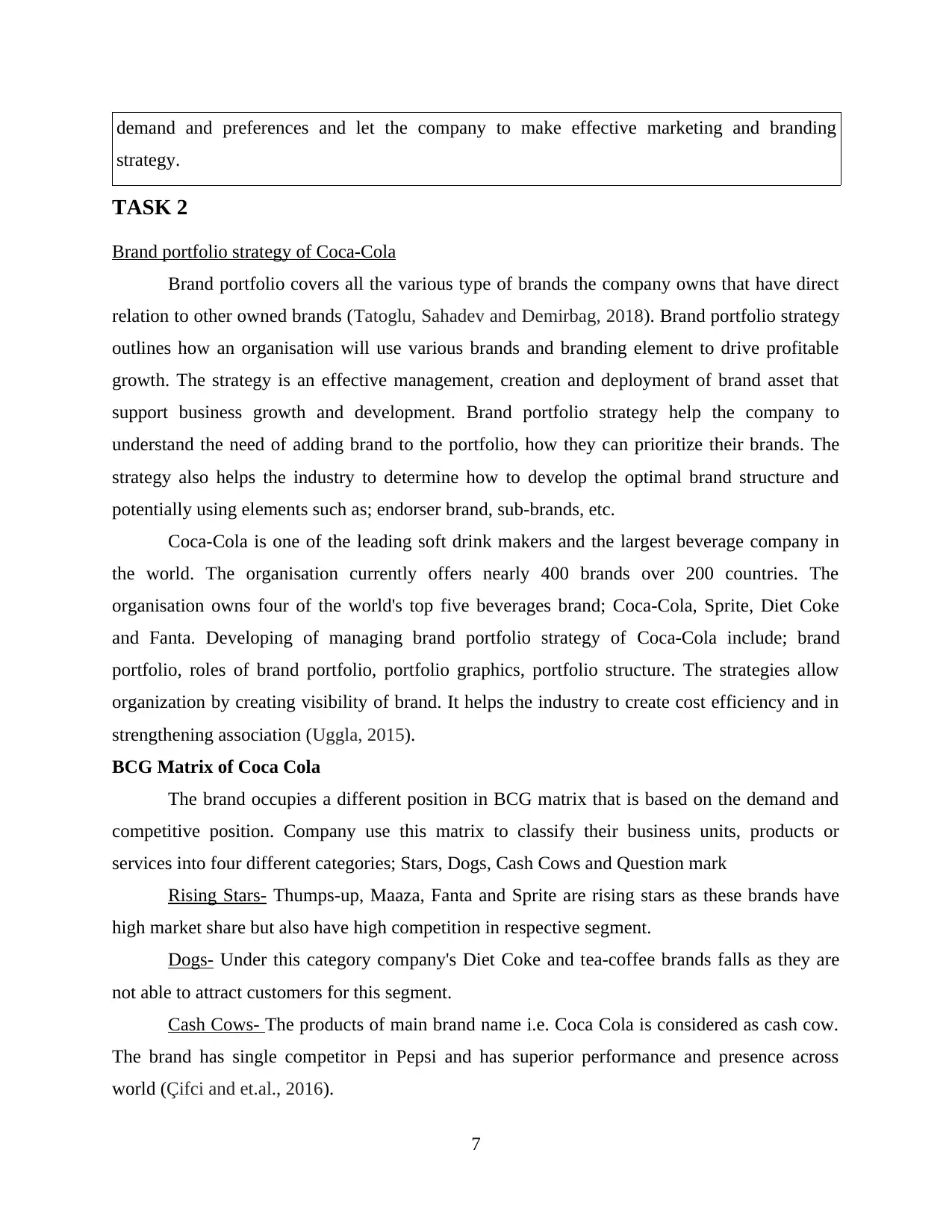
demand and preferences and let the company to make effective marketing and branding
strategy.
TASK 2
Brand portfolio strategy of Coca-Cola
Brand portfolio covers all the various type of brands the company owns that have direct
relation to other owned brands (Tatoglu, Sahadev and Demirbag, 2018). Brand portfolio strategy
outlines how an organisation will use various brands and branding element to drive profitable
growth. The strategy is an effective management, creation and deployment of brand asset that
support business growth and development. Brand portfolio strategy help the company to
understand the need of adding brand to the portfolio, how they can prioritize their brands. The
strategy also helps the industry to determine how to develop the optimal brand structure and
potentially using elements such as; endorser brand, sub-brands, etc.
Coca-Cola is one of the leading soft drink makers and the largest beverage company in
the world. The organisation currently offers nearly 400 brands over 200 countries. The
organisation owns four of the world's top five beverages brand; Coca-Cola, Sprite, Diet Coke
and Fanta. Developing of managing brand portfolio strategy of Coca-Cola include; brand
portfolio, roles of brand portfolio, portfolio graphics, portfolio structure. The strategies allow
organization by creating visibility of brand. It helps the industry to create cost efficiency and in
strengthening association (Uggla, 2015).
BCG Matrix of Coca Cola
The brand occupies a different position in BCG matrix that is based on the demand and
competitive position. Company use this matrix to classify their business units, products or
services into four different categories; Stars, Dogs, Cash Cows and Question mark
Rising Stars- Thumps-up, Maaza, Fanta and Sprite are rising stars as these brands have
high market share but also have high competition in respective segment.
Dogs- Under this category company's Diet Coke and tea-coffee brands falls as they are
not able to attract customers for this segment.
Cash Cows- The products of main brand name i.e. Coca Cola is considered as cash cow.
The brand has single competitor in Pepsi and has superior performance and presence across
world (Çifci and et.al., 2016).
7
strategy.
TASK 2
Brand portfolio strategy of Coca-Cola
Brand portfolio covers all the various type of brands the company owns that have direct
relation to other owned brands (Tatoglu, Sahadev and Demirbag, 2018). Brand portfolio strategy
outlines how an organisation will use various brands and branding element to drive profitable
growth. The strategy is an effective management, creation and deployment of brand asset that
support business growth and development. Brand portfolio strategy help the company to
understand the need of adding brand to the portfolio, how they can prioritize their brands. The
strategy also helps the industry to determine how to develop the optimal brand structure and
potentially using elements such as; endorser brand, sub-brands, etc.
Coca-Cola is one of the leading soft drink makers and the largest beverage company in
the world. The organisation currently offers nearly 400 brands over 200 countries. The
organisation owns four of the world's top five beverages brand; Coca-Cola, Sprite, Diet Coke
and Fanta. Developing of managing brand portfolio strategy of Coca-Cola include; brand
portfolio, roles of brand portfolio, portfolio graphics, portfolio structure. The strategies allow
organization by creating visibility of brand. It helps the industry to create cost efficiency and in
strengthening association (Uggla, 2015).
BCG Matrix of Coca Cola
The brand occupies a different position in BCG matrix that is based on the demand and
competitive position. Company use this matrix to classify their business units, products or
services into four different categories; Stars, Dogs, Cash Cows and Question mark
Rising Stars- Thumps-up, Maaza, Fanta and Sprite are rising stars as these brands have
high market share but also have high competition in respective segment.
Dogs- Under this category company's Diet Coke and tea-coffee brands falls as they are
not able to attract customers for this segment.
Cash Cows- The products of main brand name i.e. Coca Cola is considered as cash cow.
The brand has single competitor in Pepsi and has superior performance and presence across
world (Çifci and et.al., 2016).
7
Paraphrase This Document
Need a fresh take? Get an instant paraphrase of this document with our AI Paraphraser
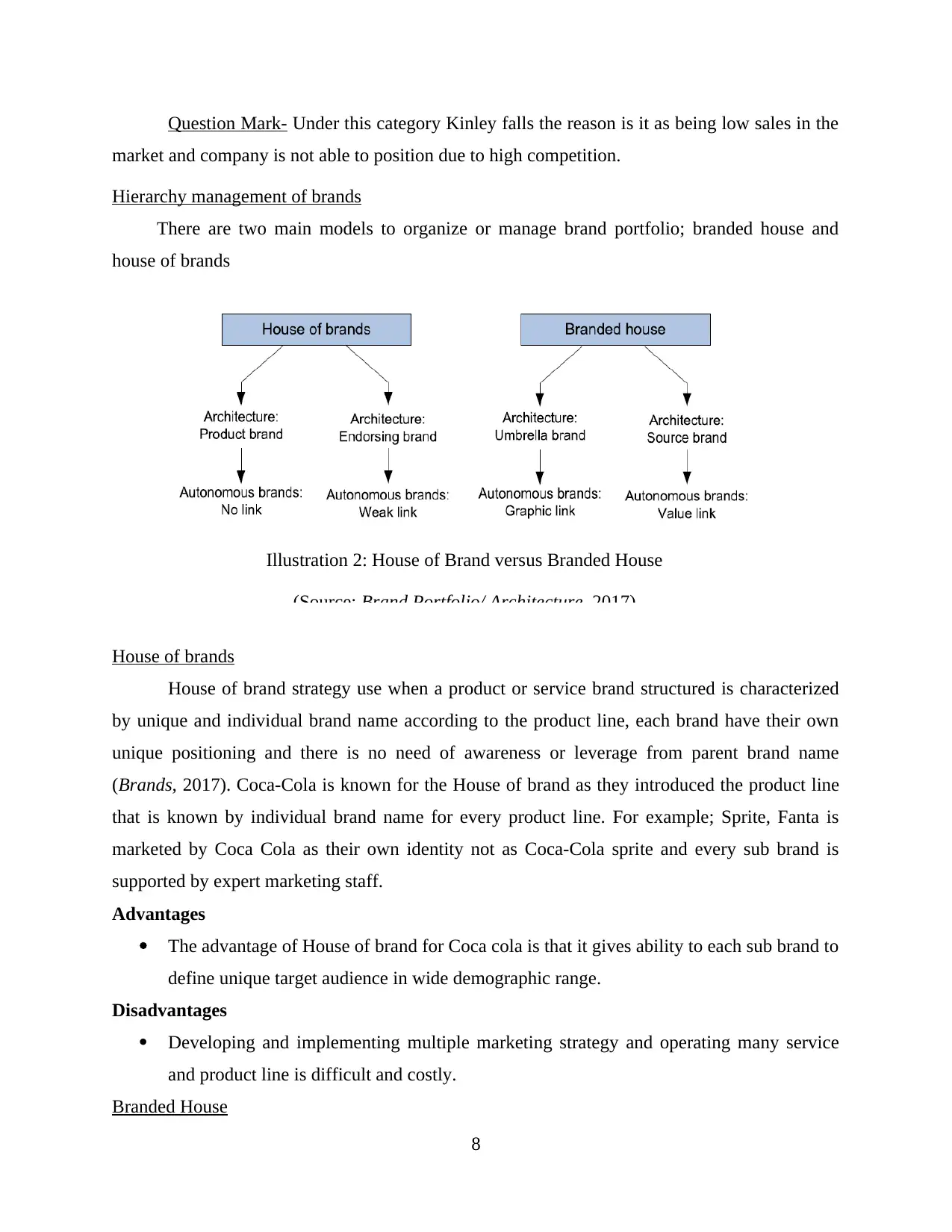
Question Mark- Under this category Kinley falls the reason is it as being low sales in the
market and company is not able to position due to high competition.
Hierarchy management of brands
There are two main models to organize or manage brand portfolio; branded house and
house of brands
House of brands
House of brand strategy use when a product or service brand structured is characterized
by unique and individual brand name according to the product line, each brand have their own
unique positioning and there is no need of awareness or leverage from parent brand name
(Brands, 2017). Coca-Cola is known for the House of brand as they introduced the product line
that is known by individual brand name for every product line. For example; Sprite, Fanta is
marketed by Coca Cola as their own identity not as Coca-Cola sprite and every sub brand is
supported by expert marketing staff.
Advantages
The advantage of House of brand for Coca cola is that it gives ability to each sub brand to
define unique target audience in wide demographic range.
Disadvantages
Developing and implementing multiple marketing strategy and operating many service
and product line is difficult and costly.
Branded House
8
Illustration 2: House of Brand versus Branded House
(Source: Brand Portfolio/ Architecture, 2017)
market and company is not able to position due to high competition.
Hierarchy management of brands
There are two main models to organize or manage brand portfolio; branded house and
house of brands
House of brands
House of brand strategy use when a product or service brand structured is characterized
by unique and individual brand name according to the product line, each brand have their own
unique positioning and there is no need of awareness or leverage from parent brand name
(Brands, 2017). Coca-Cola is known for the House of brand as they introduced the product line
that is known by individual brand name for every product line. For example; Sprite, Fanta is
marketed by Coca Cola as their own identity not as Coca-Cola sprite and every sub brand is
supported by expert marketing staff.
Advantages
The advantage of House of brand for Coca cola is that it gives ability to each sub brand to
define unique target audience in wide demographic range.
Disadvantages
Developing and implementing multiple marketing strategy and operating many service
and product line is difficult and costly.
Branded House
8
Illustration 2: House of Brand versus Branded House
(Source: Brand Portfolio/ Architecture, 2017)
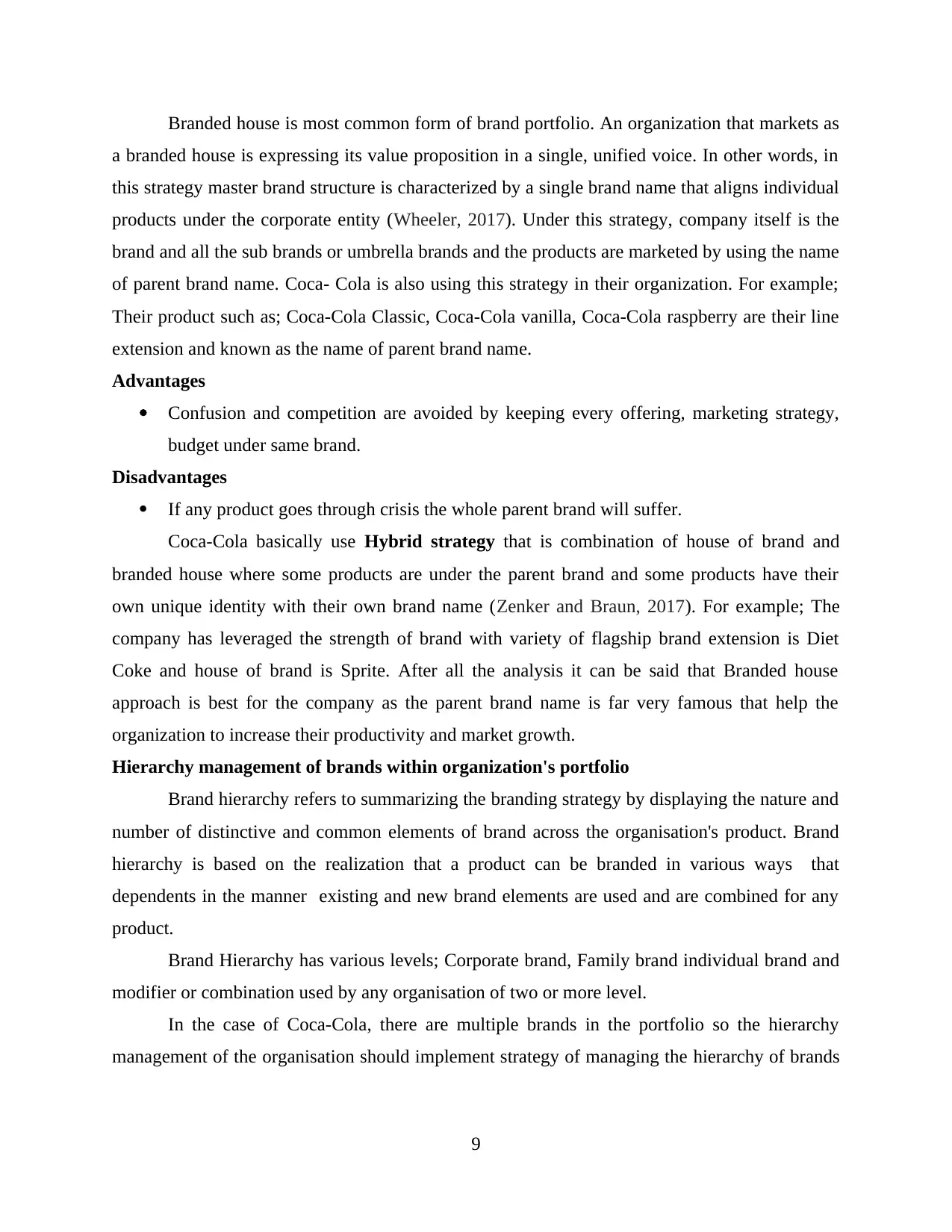
Branded house is most common form of brand portfolio. An organization that markets as
a branded house is expressing its value proposition in a single, unified voice. In other words, in
this strategy master brand structure is characterized by a single brand name that aligns individual
products under the corporate entity (Wheeler, 2017). Under this strategy, company itself is the
brand and all the sub brands or umbrella brands and the products are marketed by using the name
of parent brand name. Coca- Cola is also using this strategy in their organization. For example;
Their product such as; Coca-Cola Classic, Coca-Cola vanilla, Coca-Cola raspberry are their line
extension and known as the name of parent brand name.
Advantages
Confusion and competition are avoided by keeping every offering, marketing strategy,
budget under same brand.
Disadvantages
If any product goes through crisis the whole parent brand will suffer.
Coca-Cola basically use Hybrid strategy that is combination of house of brand and
branded house where some products are under the parent brand and some products have their
own unique identity with their own brand name (Zenker and Braun, 2017). For example; The
company has leveraged the strength of brand with variety of flagship brand extension is Diet
Coke and house of brand is Sprite. After all the analysis it can be said that Branded house
approach is best for the company as the parent brand name is far very famous that help the
organization to increase their productivity and market growth.
Hierarchy management of brands within organization's portfolio
Brand hierarchy refers to summarizing the branding strategy by displaying the nature and
number of distinctive and common elements of brand across the organisation's product. Brand
hierarchy is based on the realization that a product can be branded in various ways that
dependents in the manner existing and new brand elements are used and are combined for any
product.
Brand Hierarchy has various levels; Corporate brand, Family brand individual brand and
modifier or combination used by any organisation of two or more level.
In the case of Coca-Cola, there are multiple brands in the portfolio so the hierarchy
management of the organisation should implement strategy of managing the hierarchy of brands
9
a branded house is expressing its value proposition in a single, unified voice. In other words, in
this strategy master brand structure is characterized by a single brand name that aligns individual
products under the corporate entity (Wheeler, 2017). Under this strategy, company itself is the
brand and all the sub brands or umbrella brands and the products are marketed by using the name
of parent brand name. Coca- Cola is also using this strategy in their organization. For example;
Their product such as; Coca-Cola Classic, Coca-Cola vanilla, Coca-Cola raspberry are their line
extension and known as the name of parent brand name.
Advantages
Confusion and competition are avoided by keeping every offering, marketing strategy,
budget under same brand.
Disadvantages
If any product goes through crisis the whole parent brand will suffer.
Coca-Cola basically use Hybrid strategy that is combination of house of brand and
branded house where some products are under the parent brand and some products have their
own unique identity with their own brand name (Zenker and Braun, 2017). For example; The
company has leveraged the strength of brand with variety of flagship brand extension is Diet
Coke and house of brand is Sprite. After all the analysis it can be said that Branded house
approach is best for the company as the parent brand name is far very famous that help the
organization to increase their productivity and market growth.
Hierarchy management of brands within organization's portfolio
Brand hierarchy refers to summarizing the branding strategy by displaying the nature and
number of distinctive and common elements of brand across the organisation's product. Brand
hierarchy is based on the realization that a product can be branded in various ways that
dependents in the manner existing and new brand elements are used and are combined for any
product.
Brand Hierarchy has various levels; Corporate brand, Family brand individual brand and
modifier or combination used by any organisation of two or more level.
In the case of Coca-Cola, there are multiple brands in the portfolio so the hierarchy
management of the organisation should implement strategy of managing the hierarchy of brands
9
⊘ This is a preview!⊘
Do you want full access?
Subscribe today to unlock all pages.

Trusted by 1+ million students worldwide
1 out of 22
Related Documents
Your All-in-One AI-Powered Toolkit for Academic Success.
+13062052269
info@desklib.com
Available 24*7 on WhatsApp / Email
![[object Object]](/_next/static/media/star-bottom.7253800d.svg)
Unlock your academic potential
Copyright © 2020–2025 A2Z Services. All Rights Reserved. Developed and managed by ZUCOL.





